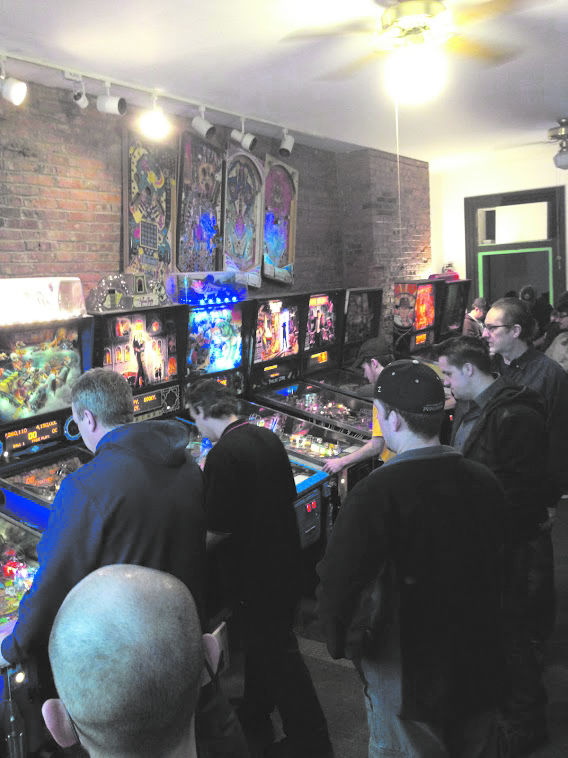Pinball in Pittsburgh: a crucial fixture in the global community
September 24, 2014
Cryss Stephens stands over a noisy, flashing “Star Trek” pinball machine, one of the newest games released by pinball giant Stern Pinball, Inc. last year. It barks orders and phrases at Stephens as he approaches his 30th-straight minute on the game. His eyes flick around the glowing neon table in stoic concentration as he bullies it, pushing and tugging at the table’s sides as the little steel ball ricochets off the game’s structures like a stray bullet.
A group of five other men stand around him, watching in silence, except for an occasional whisper or hushed gasp. One of them is Chris Meyers, owner of the Bradish Street Pinball Parlor in South Side, an arcade — featuring exclusively pinball — built from Meyer’s personal collection, which includes every machine released from the Williams/Bally company from 1979 to the present.
Ten of Meyers’ machines are polished and sturdy against the wall behind the huddle, and they’ve been turned off to avoid making any sort of distraction. Some of them are considered to be legendary in the realm of competitive pinball, a community that has found a home in Pittsburgh and is steadily growing.
“We’re pretty spoiled here in Pittsburgh,” Greg Galanter, a Pittsburgher who’s played competitive pinball since 2001, said. “There’s some pretty big stuff that goes on here.”
Pittsburgh is home to the Professional and Amateur Pinball Association (PAPA), a 30,000-square-foot warehouse in Carnegie, Pa., which has more than 450 pinball machines and hosts its annual world pinball championships that draws hundreds of players from all over the world.
“There’s only a few other cities in the world [that compare to Pittsburgh] as far as pinball is concerned,” Meyers boasts. “We have some of the best walk-up-off-the-street places where you can just drop coins and play.”
He estimates that they have a little more than 120 players in the Pittsburgh Pinball League, with the annual PAPA championship tournaments drawing upwards of 700 people.
Meyers also attributes Pittsburgh’s pinball success to the fact that it’s home to some of the top pinball players in the world, which is determined by the International Flipper Pinball Association (IFPA) — the leading global authority on pinball and player rankings.
“We probably have at least a dozen of the top 100 players in the world. We have two in the top 20 — just local guys that are incredible.”
Stephens is one of them: According to the IFPA’s ranking system, he places 14th in the world. Jon Replogle, another Pittsburgher, ranks 19th in the world. When asked if he knows who the No. 1 player is, Meyers doesn’t pause before answering: “It’s a no-brainer. It’s Keith Elwin from Carlsbad, Calif.”
Having these heavyweights around is important, because their presence at tournaments raises the stakes for others and draws challengers. The ranking system is based on players’ top 15 appearances at tournaments, which happen all over the country. The potential points a player can earn at these smaller tournaments are based primarily on the number of participants that show up and their ranking. The more top-100 players who participate in a given tournament, the more points can be won and, thus, the greater chance of climbing up the rankings.
A top player cannot just sit on their number, either — after a year of inactivity the IFPA cuts scores by 25 percent of their value. After two years, points are diminished by 50 percent, and, after three years, a player loses all of his or her points, incentivizing competitive players to travel to tournaments.
Stephens, 27, estimates that he travels once every three months for pinball — though he doesn’t have to travel far for PAPA’s world championship tournament, which usually occurs in August. PAPA’s world championship is one of the IFPA’s top three events in the world, along with the IFPA world championships and the European championships.
“The competitive aspect is way bigger [now] than it was [a few years ago],” Galanter said. In 2008, “there was probably a thousand people that would have been ranked … now there’s 28,000 in the system.”
Though there’s a broad age range of people getting into pinball, the bulk of them seem to be those who grew up in the late 1980s or early ’90s and are now in their 30s.
“It’s kind of a cult following,” Matt Schwab, a member of the Pittsburgh Pinball League, said. He hypothesizes that Pittsburgh attracts pinball because of low housing costs. “People, like myself, who grew up playing arcades in the late ’80s and early ’90s … [now] have a larger disposable income … and time.”
Meyers compares collecting pinball machines to classic cars: Both evoke nostalgia to a specific generation.
“What really gave [pinball] a shot in the arm is that people my age now have careers,” Meyers said. “They remember playing Monster Bash as a kid and think, ‘I’d like to own that table.’ [Despite] people asking for $15,000 for a game, you say, ‘but I want it, because I have money now.’”
With domestic and international interest in pinball rising, it seems like a matter of time until it shows up on ESPN.
“We’re not at the point yet where we see commercials for pinball machines,” Galanter said. “We’re not there yet. But I think we’re headed that way.”



